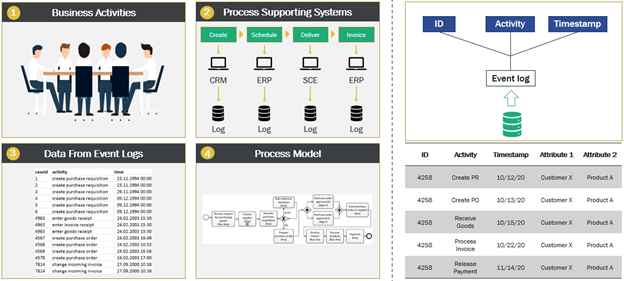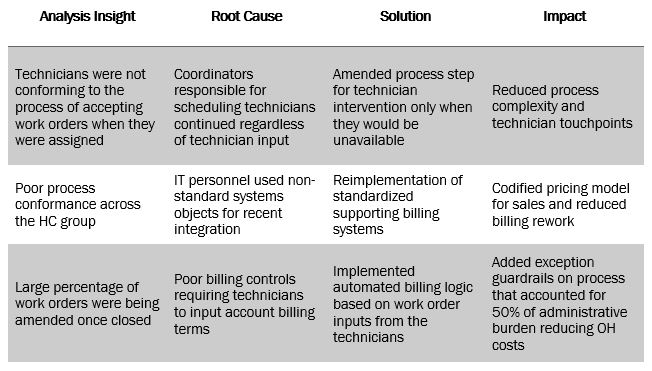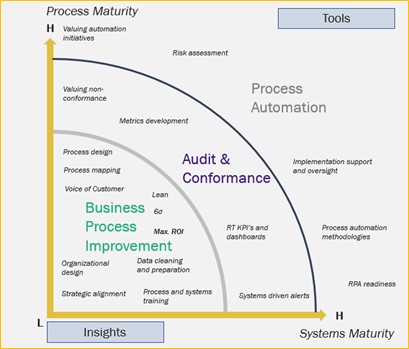Process mining can help organizations enable operational resilience, reduce financial and operational risks, catalyze automation, and enhance digital transformations.
What are organization’s biggest process challenges?
Organizations face a slew of challenges but SLKone has identified six that we feel are ubiquitous.
• Chief Operating Officers, Vice Presidents, and Managers have limited visibility into the details of their processes and lack methods for tracking conformance against true processes thereby reducing operational resilience and increasing reliance upon tribal knowledge to execute tasks
• Operational Key Performance Indicators (KPIs) have historically been indirect, disjointed measures when correlating initiatives from “top floor to shop floor”
• Difficultly in the ability to trend and view key activities at a system-level to determine which attributes are the root cause of rework, bottlenecks, and deviations
• Lack of analytical framework and tools in today’s business transformation suites that can provide that holistic view of processes
• Delays in necessary, but costly, digital transformation initiatives as ERP implementations
• Ambiguous ROI and value delivery on automation opportunities that do not always deliver on their promised value due to upstream effects
How can process mining help overcome challenges and deliver value?
Process mining can help organizations overcome their most pressing operational challenges. Gartner codifies five specific use cases for process mining: Business Process Improvement, Auditing and Compliance, Process Automation, Digital Transformation, and IT Operations.1
Every organization undergoes business process improvement initiatives. A culture of continuous improvement is imperative in today’s dynamic landscape. Process discovery enables enhanced governance and oversight through unprecedented quality and speed to insights. Initiatives are no longer burdened by bias supporting visibility and RT feedback on as-is processes.
Operational resiliency is vital at both the process and systems level. Beyond adaptability, organizations need the appropriate guard rails to mitigate operational and financial risk of their most critical activities. Process mining conformance techniques help auditing and compliance initiatives through complexity reduction, enhancement of organizational capabilities, and KPI development by comparing as-is processes to the intended design. This allows the organization to understand how well they can handle disruptions to their process.
As we work amidst a global pandemic, digital transformations are at the forefront of enabling key strategic initiatives and, frankly, survival. Employees and consumers alike have adjusted to remote work and life. Process discovery enhances the impact of digital transformations by reducing implementation delays and risks due to misunderstood processes, manual routing, and process gaps.
Process mining enhancement techniques assess the value of process automation because they create visibility and understanding of hotspots where Robotic Process Automation (RPA) and task automation will deliver the most value. According to QBR, using process mining during RPA implementation can increase the business value by 40% while reducing implementation time by 50% and project risk by 60%.2
What is process mining?
Process mining is a family of techniques in the field of process management that support the analysis of business processes based on event logs readily available in today’s information technology (IT) systems.3 Every organization has business activities that make up a process. Those processes may be supported by Enterprise Resource Planning (ERP), Customer Relationship Management (CRM), and Supply Chain Execution (SCE) software and generate event, audit, or history logs. Those logs can be used to visualize process maps of activity frequency and cycle times. By leveraging the data which is available in these logs, the process mining can begin.

The primary visuals created by process mining are used to generate hypothesis driven questions, faster, for further analysis and root-cause identification.4 Moreover, process mining vendors are working on tools that help diagnose process issues with minimal human intervention.


The three primary process mining techniques are discovery, conformance, and enhancement. Discovery is a set of techniques that manually or automatically construct a representation of an organization’s current business processes and its major process variations.5 Conformance is a family of techniques to compare a process model with an event log of the same process. It is used to check if the actual execution of a business process, as recorded in the event log, conforms to the model or vice-versa.6 Enhancement describes the analysis of a data-driven process model for optimization potential.7
Use-case: how process mining helps deliver value for SLKone clients
Process mining helps organizations reduce time to insight. Historically, process improvement engagement activities included interviews, process mapping sessions, and supplemental quantitative analysis. Therefore, processes are induced based on qualitative interviews, inputs are biased, and mapping sessions serve as the primary process discovery mechanism.
SLKone implemented process mining with a medical equipment services provider for a process improvement implementation evaluation. We experienced significant increase in the time to insights through process discovery prior to the interview process. Additionally, we saw improvements in the breadth and scope of interviews because we had quantitative ammunition. We estimate we can reduce the overall engagement length of future projects by 25%. Below are some of the results obtained from process mining.

Assessing process mining readiness
The organization, first and foremost, must determine if they have sufficient internal process mining and data cleansing capabilities. According to PwC, top challenges preventing the adoption of process mining are unavailability of process mining tooling or expertise (52%), limited focus due to a missing process function (33%), and a complex IT landscape (30%). According to Gartner, 80% of the efforts and time are spent on locating, selecting, extracting, and transforming the process data. The time needed to apply process mining is short when the data are there.
Assuming your organization has sufficient process mining and data cleaning capabilities, it is important to determine the maturity across business processes and supporting systems. Mature business processes mean the organization has standardized and documented processes that serve as the benchmark for conformance with clear inputs, outputs, and metrics. Mature systems mean the organization has technology that support and track all activities. Measuring your organization along each scale will help dictate how ready the organization is for process mining insights or tools. Insights leverage process mining as an analysis tool to drive actionable value.
Tools are solutions from process mining software providers that can be implemented across functions or at scale. SLKone has developed a framework to help organizations assess their readiness. It naturally follows the three primary use cases (business process improvement, audit and conformance, process automation) across the three techniques (discovery, conformance, and enhancements). The italicized text in the figure below represents the activities required to move from low to high across process and systems maturity.

How we can help
Process mining is a fantastic tool for deriving rapid insights into your processes. If your organization is one of the 79% that has never heard of process mining and are interested in unlocking operational efficiency and effectiveness, SLKone is here to help – regardless of your organization’s level of maturity.
For insights, SLKone deploys a suite of open-source tools to evaluate an organization’s process health, diagnose key issues, and develop and deploy process documentation and training. As management consultants with exceptional data skills, we can help collect and make sense of the data for process mining applications. Once we have modeled the process, the value we provide is strategic insights that can be operationalized.
It is important to note that process mining initiatives do not require the adoption of process mining software. Process mining is simply a tool that enables operational insights, better and faster. We leveraged process mining techniques to guide development of real-time operational dashboards providing provide visibility and guardrails for key stakeholders within the organization’s ERPs and CRMs. Dashboards tracked queues, bottlenecks, and key deviations for intervention.
Organizations that would like to leverage open-source tools for insights may want to consider how they can begin to leverage open-source stacks to drive meaningful data science initiatives, beyond process mining, within their organization. We believe that real data science is done with code. That is why we believe in having coding skills as management consultants and like to work at the intersection of business generalists and data scientists.
For organizations looking to procure tools, there are some great vendors doing amazing things. SLKone is partnering with market leaders to deliver those insights and help guide the organization’s implementation. The scale of adoption and current software stacks are some of the factors that guide the decision making. We can help evaluate what tool makes sense for your business needs through partnerships with operations excellence teams. The goal in this type of engagement is to help organizations with the proof the value of process mining, overcome capability gaps, and drive adoption as a continuous improvement tool.
Bottomline, we can help no matter where you are in your process mining journey. Reach out to learn more.
1Gartner, Market Guide for Process Mining
2AI Multiple, 20 Process Mining Statistics
3Wikipedia, Process mining
4bupaR, Process Maps
5Wikipedia, Business process discovery
6Wikipedia, Conformance checking
7Lana, Model Enhancement
Download this Article as a PDF